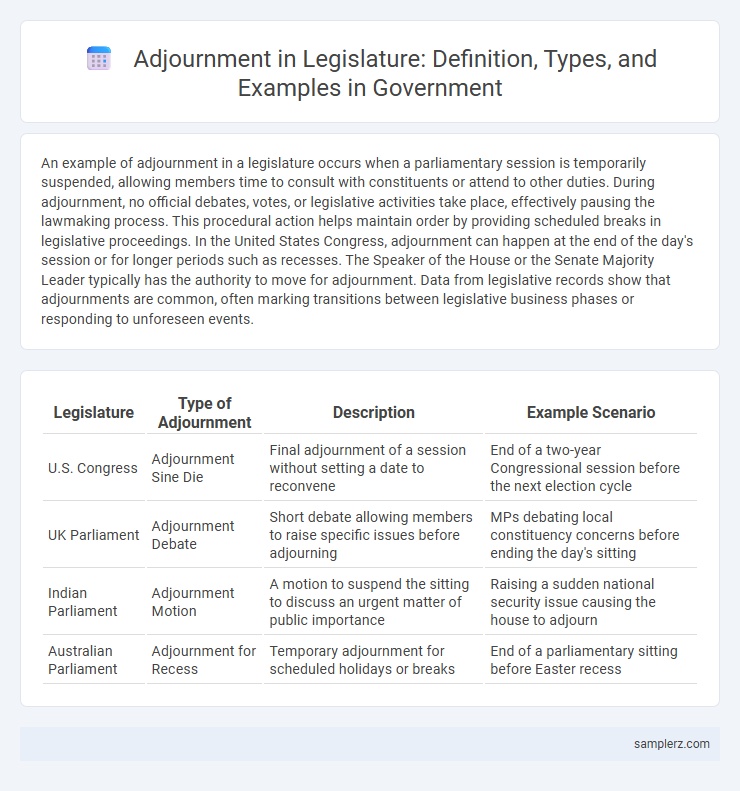An example of adjournment in a legislature occurs when a parliamentary session is temporarily suspended, allowing members time to consult with constituents or attend to other duties. During adjournment, no official debates, votes, or legislative activities take place, effectively pausing the lawmaking process. This procedural action helps maintain order by providing scheduled breaks in legislative proceedings. In the United States Congress, adjournment can happen at the end of the day's session or for longer periods such as recesses. The Speaker of the House or the Senate Majority Leader typically has the authority to move for adjournment. Data from legislative records show that adjournments are common, often marking transitions between legislative business phases or responding to unforeseen events.
Table of Comparison
| Legislature | Type of Adjournment | Description | Example Scenario |
|---|---|---|---|
| U.S. Congress | Adjournment Sine Die | Final adjournment of a session without setting a date to reconvene | End of a two-year Congressional session before the next election cycle |
| UK Parliament | Adjournment Debate | Short debate allowing members to raise specific issues before adjourning | MPs debating local constituency concerns before ending the day's sitting |
| Indian Parliament | Adjournment Motion | A motion to suspend the sitting to discuss an urgent matter of public importance | Raising a sudden national security issue causing the house to adjourn |
| Australian Parliament | Adjournment for Recess | Temporary adjournment for scheduled holidays or breaks | End of a parliamentary sitting before Easter recess |
Definition and Purpose of Adjournment in Legislature
Adjournment in legislature refers to the suspension of a parliamentary session either temporarily or until the next scheduled meeting. The primary purpose of adjournment is to allow legislators time for consultation, preparation of bills, and attending to constituency matters. It also serves to manage legislative schedules efficiently and provide breaks during prolonged sessions.
Key Procedures for Adjournment in Parliamentary Systems
Adjournment in parliamentary systems involves formal procedures such as a motion for adjournment, which must be proposed, debated, and voted upon by members. Key steps include a fixed time or condition set for resumption, ensuring orderly suspension without dissolving the assembly, and adherence to standing orders governing the duration and circumstances of the adjournment. This process maintains legislative continuity and respects procedural rules established within the government framework.
Notable Historical Examples of Legislative Adjournment
The 1974 U.S. Congressional adjournment during the Watergate scandal allowed lawmakers to address President Nixon's impeachment proceedings without interruption, demonstrating the strategic use of legislative pauses. In 2019, the UK Parliament experienced a significant prorogation initiated by Prime Minister Boris Johnson, which was later ruled unlawful and underscored the critical balance between executive power and parliamentary sovereignty. Australia's 1975 constitutional crisis saw the Senate's adjournment contribute to the dismissal of Prime Minister Gough Whitlam, highlighting the pivotal role adjournments can play in parliamentary power struggles.
Adjournment Motion: Process and Significance
An Adjournment Motion in the legislature allows members to suspend proceedings to discuss urgent issues not on the agenda, requiring approval by a majority vote. This process ensures timely attention to critical matters while maintaining parliamentary discipline. The significance lies in providing a structured mechanism for legislative oversight and accountability between formal sessions.
Differences Between Adjournment, Prorogation, and Recess
Adjournment in a legislature refers to the suspension of a session for a short period, often a few hours or days, allowing members to temporarily halt proceedings without dissolving the assembly. Unlike prorogation, which ends a parliamentary session and clears all pending business until the next session begins, adjournment preserves ongoing legislative work for continuation later. Recess, on the other hand, is a longer break scheduled between sessions, providing lawmakers with extended time away but without ending the session itself.
Case Study: Adjournment in the United States Congress
The United States Congress frequently employs adjournment to pause legislative sessions, allowing members to attend to constituent matters or campaign activities. For instance, during the 2013 federal government shutdown, Congress adjourned without passing a budget, triggering a 16-day halt in government operations. This case study illustrates how adjournment functions as a legislative tool that can reflect political stalemates and impact governance.
Role of the Speaker in Legislative Adjournment
The Speaker plays a critical role in legislative adjournment by maintaining order and determining the appropriate timing for recess or closure of sessions. This authority ensures procedural compliance and facilitates effective legislative workflow while preventing disruptions. The Speaker's decisions on adjournment can significantly impact legislative agendas and the passage of key bills.
Impact of Adjournment on Legislative Business
Adjournment in a legislature temporarily halts legislative sessions, causing delays in the passage of bills and critical policy discussions. Such interruptions can lead to backlog in lawmaking processes and hinder timely government responsiveness to public needs. Prolonged adjournments may also affect budget approvals and oversight functions essential for effective governance.
Challenges and Controversies Surrounding Adjournment
Adjournment in legislature often faces challenges such as allegations of misuse to delay critical debates or avoid accountability, leading to controversies over democratic transparency. Political parties may exploit adjournment motions as a strategic tool to disrupt proceedings rather than address legislative business. These practices can undermine public trust and hinder the effective functioning of parliamentary democracy.
International Practices: Adjournment in Global Legislatures
In global legislatures, adjournment serves as a procedural tool allowing sessions to suspend temporarily, exemplified by the UK Parliament's prorogation, which halts all parliamentary business until the next session. The Indian Lok Sabha frequently employs adjournment motions to address urgent public matters, compelling government responses and debates. Similarly, the US Congress uses recess adjournments to pause legislative activities, often coordinating with federal holidays and political negotiations.

example of adjournment in legislature Infographic
 samplerz.com
samplerz.com